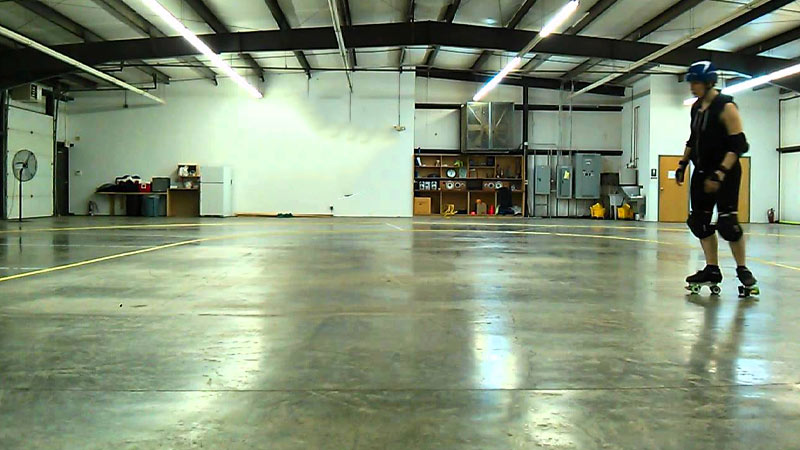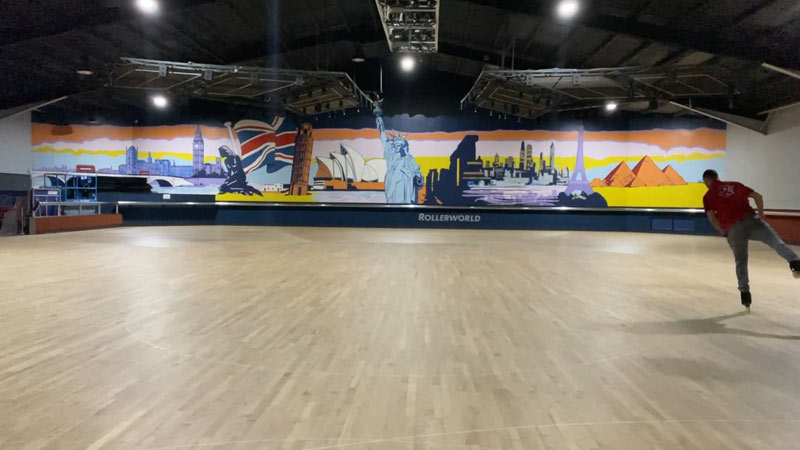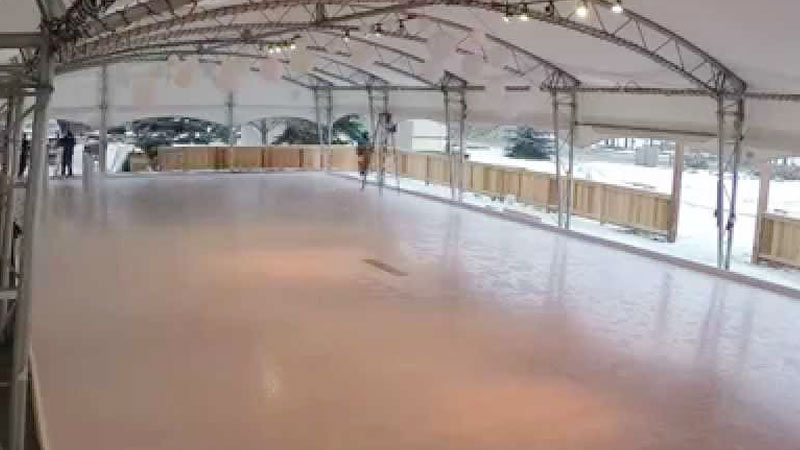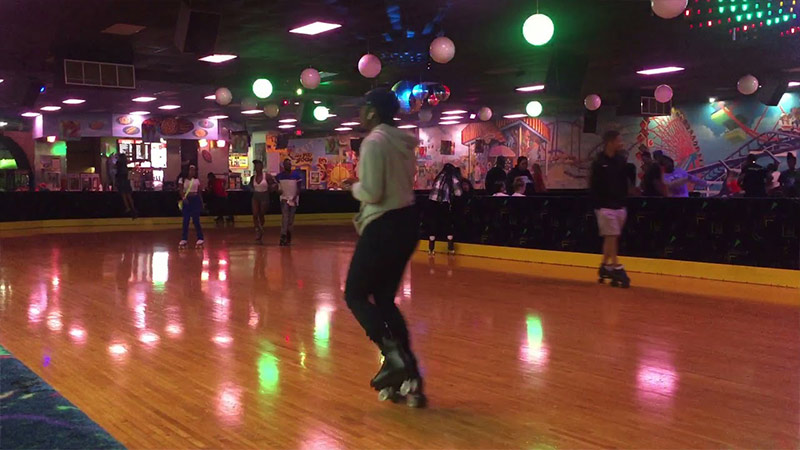Skating rinks are a hub of joy and entertainment, where skaters of all ages glide gracefully on smooth surfaces. Yet, beneath those twirling wheels or ice skates lies a fundamental aspect that profoundly impacts the skating experience.
Have you ever wondered what skating rink floors are made of? In this blog post, we’ll embark on a fascinating journey to uncover the secrets beneath the surface.
From the classic hardwood maple floors of indoor roller skating rinks to the refrigerated concrete bases of ice skating rinks, each type of rink floor material serves a unique purpose, offering skaters an ideal platform for their chosen activity.
We’ll delve into the materials, construction, and maintenance, shedding light on the intricacies that make rinks both safe and enjoyable.
So, whether you’re a seasoned skater or just curious about the magic that happens under your feet at the rink, read on to explore the world of skating rink floors.
What Are Skating Rink Floors Made Of?
Skating rink floors are typically made of a few different materials, depending on the type of skating and the specific requirements of the rink. Here are some common skating rink flooring materials:
Wood
Traditional indoor roller skating rinks often have wooden floors. Hardwood maple is a popular choice due to its durability, smooth surface, and good traction for roller skaters.
The wood is usually treated to withstand the wear and tear of skates and regular maintenance is required to keep it in good condition.
Concrete
Many outdoor roller skating rinks and some indoor roller and inline skating rinks use concrete floors.
Concrete is durable and can withstand heavy use and exposure to the elements. Concrete floors are often coated with a smooth surface, such as epoxy or urethane, to provide a suitable skating surface.
Synthetic Flooring
Some modern indoor skating rinks use synthetic flooring materials like plastic, PVC, or polyurethane.
These materials are designed to be smooth and durable, providing an excellent surface for roller skating and inline skating. They are also easier to maintain than wood and concrete.
Ice
In the case of ice skating rinks, the floor is made of a special refrigerated concrete or sand base covered with layers of ice.
The ice surface is maintained at sub-freezing temperatures to provide a smooth and slippery surface for ice skaters.
Sport Court Tiles
Some multi-purpose sports facilities or temporary skating rinks may use interlocking sport court tiles made of materials like polypropylene or polyethylene.
These tiles are durable, easy to install, and provide a smooth surface for roller skating, roller hockey, or other skating activities.
The choice of flooring material depends on factors such as the type of skating budget, and maintenance considerations. Proper maintenance is essential to keep the skating surface in good condition and to ensure the safety of skaters.
The Basics of Skating Rink Floors

The flooring of a skating rink is a fundamental component that significantly affects the skating experience and safety of the skaters. Here are the basics of skating rink floors:
Material Selection
Skating rink floors can be made of various materials, including wood, concrete, synthetic materials, and ice, depending on the type of skating and the rink’s location.
- Wood: Traditional indoor roller skating rinks often use hardwood maple for its smooth surface and good traction.
- Concrete: Outdoor roller skating rinks and some indoor rinks use concrete floors coated with a smooth surface like epoxy or urethane.
- Synthetic Materials: Modern indoor rinks may feature synthetic materials like plastic, PVC, or polyurethane for a smooth, durable surface.
- Ice: Ice skating rinks have a refrigerated concrete or sand base covered with layers of ice.
Surface Smoothness
Skating rink floors must have a smooth and level surface to ensure a safe and enjoyable skating experience.
Any irregularities, cracks, or imperfections in the floor can pose tripping hazards and should be addressed through regular maintenance and repair.
Traction and Slip Resistance
The floor should provide the right balance of traction and slip resistance for the type of skating being done.
Wood and synthetic floors may require the application of specialized coatings or finishes to optimize traction.
Maintenance
Regular maintenance is essential to keep the skating surface in good condition and ensure the safety of skaters. This may include cleaning, repairing any damage, and reapplying finishes or coatings as needed.
Safety Considerations
Skating rink floors should meet safety standards to minimize the risk of accidents and injuries. Adequate lighting, signage, and barriers may also be important for safety.
Indoor vs. Outdoor
Indoor rinks offer controlled environments and are less exposed to weather conditions, making them suitable for wood or synthetic floors.
Outdoor rinks may use concrete or other durable materials that can withstand exposure to the elements.
Adaptability
Some skating rinks are designed for multi-purpose use and may have removable or interchangeable flooring to accommodate different activities, such as roller hockey or basketball.
Ice Maintenance
In the case of ice skating rinks, maintaining the ice surface at sub-freezing temperatures and regularly resurfacing it is essential for a smooth and safe skating experience.
The specific requirements for a skating rink floor can vary depending on factors such as the type of skating, the location of the rink, and the budget.
Properly maintaining the floor and ensuring it meets safety standards are crucial for the well-being of skaters and the success of the rink.
Roller Skating Rink Floor Material
Roller skating rink floors are typically made of one of the following materials:
Hardwood Maple

Hardwood maple is a popular choice for indoor roller skating rink floors. It is known for its durability, smooth surface, and excellent traction for roller skaters.
Maple flooring is often preferred because it provides a consistent and high-quality surface for roller skating.
The wood is usually treated and finished to withstand the wear and tear of skates, ensuring a long-lasting and smooth skating experience.
Synthetic Flooring
Some modern indoor roller skating rinks use synthetic flooring materials like plastic, PVC, or polyurethane. These materials are designed to be smooth, durable, and low-maintenance.
They provide an excellent surface for roller skating and are easier to clean and maintain than traditional wood floors.
The choice between hardwood maple and synthetic flooring can depend on factors such as budget, maintenance considerations, and the specific needs of the skating rink.
Hardwood maple is a classic choice that many roller rinks prefer, while synthetic materials offer convenience and versatility for some rink owners.
Ice Skating Rink Floors Material
Ice skating rink floors are quite different from the typical solid floors found in roller skating rinks. An ice skating rink’s floor is a refrigerated surface designed to create and maintain a sheet of ice.
Here’s a basic overview of the materials used for ice skating rink floors:
Concrete or Sand Base
The base of an ice skating rink is typically constructed using concrete or sand. This base provides the structural support and stability required to create and maintain the ice surface.
The choice between concrete and sand may depend on the specific design of the rink and environmental factors.
Refrigeration System
The key component of an ice skating rink floor is the refrigeration system. Pipes or tubes are embedded within the concrete or sand base, and a coolant, such as glycol, circulates through these pipes.
This refrigeration system is responsible for cooling the floor surface and maintaining it at sub-freezing temperatures, which allows the water on the surface to freeze and create the ice sheet.
Ice Surface
Once the base is in place and the refrigeration system is operational, a layer of water is applied to the floor.
Multiple layers of water are added, allowing each layer to freeze and build up the ice surface. This process is repeated until the desired thickness of the ice sheet is achieved.
The maintenance and operation of an ice skating rink floor are critical to keeping the ice in good condition for skaters. This includes regular resurfacing to repair any imperfections or cracks that may develop on the ice surface.
The refrigeration system must also be continuously monitored to ensure that the ice remains at the appropriate temperature for safe and enjoyable ice skating.
Outdoor Skating Rink Floors
Outdoor skating rink floors are designed to withstand exposure to the elements and provide a suitable surface for various types of skating, including ice skating and roller skating.
The choice of materials for outdoor skating rink floors is influenced by durability, weather resistance, and maintenance considerations.
Here are some common types of outdoor skating rink floors:
Concrete

Many outdoor roller skating rinks and roller hockey rinks use concrete floors as the base material. Concrete is durable and can withstand exposure to the elements.
It is typically treated with a smooth surface coating, such as epoxy or urethane, to create a suitable skating surface. Proper maintenance is necessary to keep the surface smooth and safe.
Asphalt
Some outdoor roller skating rinks and roller hockey rinks use asphalt surfaces. Asphalt provides a relatively smooth and durable surface, but it may require regular resurfacing and maintenance to ensure a safe skating experience.
Natural Ice
In colder climates, outdoor ice skating rinks often utilize natural ice formed on frozen bodies of water, such as ponds or lakes.
These rinks do not have a specific “floor” material, but the ice surface itself serves as the skating area. Maintenance includes regular clearing of snow and resurfacing to maintain a smooth ice surface.
Synthetic Tiles
Interlocking sport court tiles made of materials like polypropylene or polyethylene are sometimes used for temporary or portable outdoor skating rinks.
These tiles are durable, easy to install, and can provide a smooth and consistent surface for roller skating or roller hockey.
Polyurethane or Plastic Surfaces
Some outdoor roller skating rinks use specially designed polyurethane or plastic surfaces that are weather-resistant and provide a smooth, low-friction skating experience.
These surfaces can be more forgiving than concrete or asphalt and are relatively easy to install.
The specific choice of material for outdoor skating rink floors can depend on factors such as climate, budget, maintenance capabilities, and the intended use of the rink.
Regardless of the material, regular maintenance is crucial to ensure the safety and quality of the skating surface, especially when exposed to varying weather conditions.
Environmental Considerations for Rink Floor Material

Choosing the right rink floor material involves several environmental considerations to minimize the impact on the environment and promote sustainability.
Here are some environmental factors to take into account when selecting rink floor materials:
Sustainability
Opt for materials that are sourced and produced sustainably. Look for certifications like Forest Stewardship Council (FSC) for wood or certifications for sustainable production methods for synthetic materials.
Energy Efficiency
For indoor rinks, consider the energy efficiency of the flooring material. Efficient temperature regulation and insulation can reduce energy consumption for cooling or heating the rink.
Low VOC Emissions
Volatile Organic Compounds (VOCs) released from certain flooring materials can contribute to indoor air pollution. Choose low-VOC or VOC-free materials to maintain good indoor air quality for skaters and staff.
Recyclability
Evaluate whether the rink floor material can be recycled or repurposed at the end of its life cycle to reduce waste and promote a circular economy.
Durability
Select materials that are long-lasting and require fewer replacements or repairs. Durable floors can extend their lifespan, reducing the need for new materials and the associated environmental impact.
Minimal Maintenance
Choose materials that are easy to clean and maintain. Minimizing the use of harsh chemicals and reducing water consumption for cleaning can be environmentally friendly.
Local Sourcing
Whenever possible, source materials locally to reduce transportation-related emissions. Locally sourced materials also support local economies.
Low-Waste Installation
Opt for installation methods that generate minimal waste and consider reusing or recycling materials leftover from the installation process.
Environmental Impact Assessment
Conduct a comprehensive environmental impact assessment to evaluate the life cycle of the rink floor material, including its extraction, production, transportation, use, and disposal.
Water Conservation
If the rink is subject to water usage for ice resurfacing or other purposes, implement water conservation measures and consider the environmental impact of water sourcing.
Regulatory Compliance
Ensure that the chosen rink floor material complies with local and national environmental regulations and standards.
Green Building Certifications
If applicable, consider seeking green building certifications like LEED for your facility. These certifications promote environmentally responsible and resource-efficient building practices.
Natural Landscaping
Surrounding landscaping can also affect the environmental impact of a rink. Consider using native, drought-resistant plants to reduce water usage and support local ecosystems.
By considering these environmental factors when choosing and maintaining rink floor materials, rink owners can reduce their facility’s environmental footprint and contribute to a more sustainable and eco-friendly operation.
FAQs
What is a smooth enclosed floor for roller skating called?
A smooth enclosed floor designed for roller skating is typically called a “skating rink floor” or simply a “skating floor.”
It provides a flat and smooth surface for roller skaters to enjoy a frictionless experience.
Why is the skating floor so smooth?
Skating floors are intentionally made smooth to minimize friction and provide an optimal surface for roller skaters.
The smoothness allows skaters to glide more easily, reducing the effort required to move and enhancing their overall skating experience.
What is a skating rink floor made of?
Skating rink floors are commonly made of a combination of materials. The primary components are usually a smooth hardwood surface, such as maple, that is reinforced with several layers of plywood.
This construction creates a durable and resilient skating surface.
Is skating flooring material cheap?
The cost of skating rink flooring material can vary depending on the quality of materials used and the size of the rink.
While some cheaper options may be available, high-quality hardwood floors and proper installation can be relatively expensive.
What are roller rink floors made of?
Roller rink floors are typically made of hardwood, particularly maple, due to its durability and smooth texture.
This hardwood is layered over a base of plywood, creating a strong and resilient foundation for roller skating.
Wrapping Up
Skating rinks are places of wonder and joy, where the magic of gliding effortlessly meets the hard work of maintaining the perfect skating surface.
From traditional hardwood maple floors in roller skating rinks to the intricate refrigeration systems that transform concrete into a skating wonderland, the materials and techniques behind skating rink floors play a crucial role in ensuring a safe and enjoyable experience for skaters.
Understanding the composition and care of these floors is not only fascinating but also essential for rink owners and skating enthusiasts alike.
With the right choice of materials and proper maintenance, skating rinks can continue to be cherished community spaces, providing endless fun for generations to come.
The next time you step onto the rink, you’ll have a deeper appreciation for the science and artistry that lies beneath your skates.







